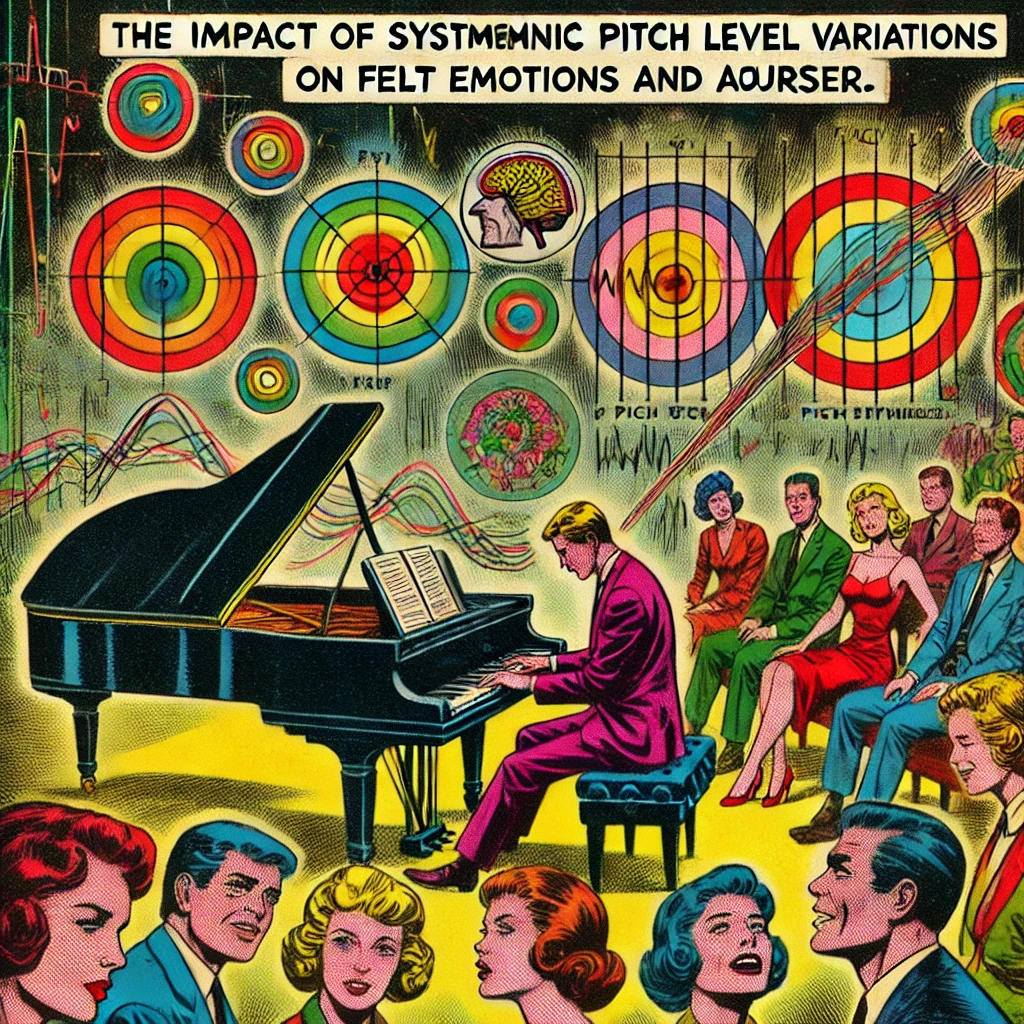Music and felt emotions
Abstract
“There was also a significant, yet smaller, negative relationship between pitch level and arousal, moderated by gender: Compared to higher pitch, lower pitch was associated with higher arousal in men only.”
Content
Music and felt emotions: How systematic pitch level variations affect the experience of pleasantness and arousal
Lucas Jaquet
Brigitta Danuser
Patrick Gomez
Institut universitaire romand de Santé au Travail (Institute for Work and Health), University of Lausanne and University of Geneva, Lausanne, Switzerland
Patrick Gomez, Institute for Work and Health, Rue du Bugnon 21, Lausanne 1011, Switzerland. Email: patrick.gomez@hospvd.ch
Abstract
Pitch is a fundamental musical factor; however, findings about its contribution to the elicitation of emotions are contradictory. The purpose of this work was to assess the effect of systematic pitch variations on self-reports of felt valence and arousal. In a within-subject design, 49 subjects listened to four 1-minute classical piano excerpts, each presented at three different pitch levels (one octave lower than the original version, the original version and one octave higher than the original version). Compared to excerpts both without octave modification and in the +1 octave variant, pleasantness of excerpts in the -1 octave variant was significantly lower. This main effect was stronger for women than men and, importantly, was modulated by the specific characteristics of the stimuli. There was also a significant, yet smaller, negative relationship between pitch level and arousal, moderated by gender: Compared to higher pitch, lower pitch was associated with higher arousal in men only. Regarding the complex outcomes of this study, future studies should investigate to which extent our findings can be generalized to other musical works. The ultimate goal might be to demonstrate how pitch level interacts with other musical features and listeners’ characteristics in eliciting diverse affective experiences.
http://pom.sagepub.com/content/42/1/51.abstract
The relationship between music and emotions is a complex and multifaceted phenomenon that has been studied extensively in the fields of psychology, neuroscience, and music cognition. Systematic pitch level variations in music can indeed influence the experience of pleasantness and arousal, as they contribute to the overall emotional impact of a musical piece. Here’s how this relationship can be understood:
1. Pitch and Emotional Connotations: Pitch is one of the fundamental dimensions of music that contributes to its emotional expression. Different pitch levels can evoke different emotional connotations or associations. For example, higher pitch levels are often associated with feelings of lightness, brightness, and excitement, while lower pitch levels are associated with feelings of darkness, depth, and seriousness.
2. Melodic Contour: The contour or shape of a melody, which is determined by its pitch level variations over time, plays a crucial role in shaping the emotional trajectory of a musical piece. Melodies with ascending pitch contours tend to convey feelings of rising tension, anticipation, and excitement, while melodies with descending contours may evoke feelings of relaxation, resolution, and melancholy.
3. Arousal and Pleasantness: Systematic pitch level variations can influence both the arousal level and the perceived pleasantness of a musical piece. Research suggests that music with dynamic pitch changes and contrasting pitch levels can evoke heightened arousal and emotional intensity in listeners. Additionally, the direction and trajectory of pitch changes can affect the overall emotional valence of the music, with upward pitch movements often associated with positive emotions and downward movements with negative emotions.
4. Cultural and Individual Differences: It’s important to note that the emotional effects of pitch level variations in music can be influenced by cultural factors, individual differences, and contextual factors. What is perceived as pleasant or arousing in one cultural context may differ from another, and individuals may have unique emotional responses to music based on their personal preferences, experiences, and background.
5. Music Theory and Composition: In music theory and composition, composers often use pitch level variations strategically to convey specific emotional themes, narrative arcs, or expressive intentions. By manipulating pitch levels, composers can create emotional contrasts, build tension and release, and guide listeners through a rich emotional landscape.
Overall, systematic pitch level variations play a crucial role in shaping the emotional experience of music, contributing to its overall affective impact on listeners. The interplay between pitch, emotion, and music perception is a fascinating area of research that continues to deepen our understanding of the profound ways in which music can affect our emotions and experiences.
